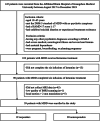Functional connectivity of the amygdala subregions and the antidepressant effects of repeated ketamine infusions in major depressive disorder
- PMID: 38572583
- PMCID: PMC11059247
- DOI: 10.1192/j.eurpsy.2024.1744
Functional connectivity of the amygdala subregions and the antidepressant effects of repeated ketamine infusions in major depressive disorder
Abstract
Background: Amygdala subregion-based network dysfunction has been determined to be centrally implicated in major depressive disorder (MDD). Little is known about whether ketamine modulates amygdala subarea-related networks. We aimed to investigate the relationships between changes in the resting-state functional connectivity (RSFC) of amygdala subregions and ketamine treatment and to identify important neuroimaging predictors of treatment outcomes.
Methods: Thirty-nine MDD patients received six doses of ketamine (0.5 mg/kg). Depressive symptoms were assessed, and magnetic resonance imaging (MRI) scans were performed before and after treatment. Forty-five healthy controls underwent one MRI scan. Seed-to-voxel RSFC analyses were performed on the amygdala subregions, including the centromedial amygdala (CMA), laterobasal amygdala (LBA), and superficial amygdala subregions.
Results: Abnormal RSFC between the left LBA and the left precuneus in MDD patients is related to the therapeutic efficacy of ketamine. There were significant differences in changes in bilateral CMA RSFC with the left orbital part superior frontal gyrus and in changes in the left LBA with the right middle frontal gyrus between responders and nonresponders following ketamine treatment. Moreover, there was a difference in the RSFC of left LBA and the right superior temporal gyrus/middle temporal gyrus (STG/MTG) between responders and nonresponders at baseline, which could predict the antidepressant effect of ketamine on Day 13.
Conclusions: The mechanism by which ketamine improves depressive symptoms may be related to its regulation of RSFC in the amygdala subregion. The RSFC between the left LBA and right STG/MTG may predict the response to the antidepressant effect of ketamine.
Keywords: amygdala subregion; antidepressant; functional connectivity; ketamine; major depressive disorder.
Conflict of interest statement
The authors declare none.
Figures




Similar articles
-
Functional connectivity of the amygdala and the antidepressant and antisuicidal effects of repeated ketamine infusions in major depressive disorder.Front Neurosci. 2023 Feb 2;17:1123797. doi: 10.3389/fnins.2023.1123797. eCollection 2023. Front Neurosci. 2023. PMID: 36816116 Free PMC article.
-
Abnormal resting-state functional connectivity in subregions of amygdala in adults and adolescents with major depressive disorder.BMC Psychiatry. 2024 Jul 31;24(1):540. doi: 10.1186/s12888-024-05977-9. BMC Psychiatry. 2024. PMID: 39085839 Free PMC article.
-
Functional connectivity differences in the amygdala are related to the antidepressant efficacy of ketamine in patients with anxious depression.J Affect Disord. 2023 Jan 1;320:29-36. doi: 10.1016/j.jad.2022.09.125. Epub 2022 Sep 28. J Affect Disord. 2023. PMID: 36181911
-
Effect of ketamine on task-based functional magnetic resonance imaging findings in major depressive disorder: A mini-review.J Affect Disord. 2025 Feb 1;370:181-189. doi: 10.1016/j.jad.2024.10.118. Epub 2024 Nov 2. J Affect Disord. 2025. PMID: 39489183 Review.
-
Neuroimaging-Derived Biomarkers of the Antidepressant Effects of Ketamine.Biol Psychiatry Cogn Neurosci Neuroimaging. 2023 Apr;8(4):361-386. doi: 10.1016/j.bpsc.2022.11.005. Epub 2022 Nov 26. Biol Psychiatry Cogn Neurosci Neuroimaging. 2023. PMID: 36775711 Free PMC article. Review.
Cited by
-
European Psychiatry: 2024 in review.Eur Psychiatry. 2025 Jan 27;68(1):1-7. doi: 10.1192/j.eurpsy.2025.4. Online ahead of print. Eur Psychiatry. 2025. PMID: 39865842 Free PMC article. No abstract available.
References
-
- Mueller TI, Leon AC, Keller MB, Solomon DA, Endicott J, Coryell W, et al. Recurrence after recovery from major depressive disorder during 15 years of observational follow-up. Am J Psychiatry. 1999;156(7):1000–6. - PubMed
Publication types
MeSH terms
Substances
LinkOut - more resources
Full Text Sources
Medical

